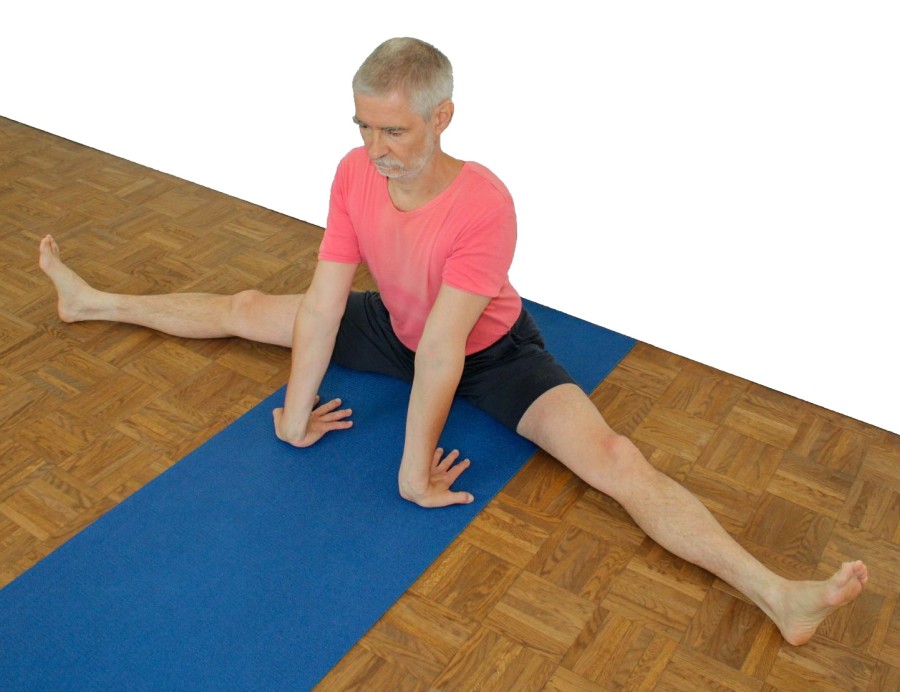yogabook / functional exercises / palmar forearm stretch in upavista konasana
Contents
Palmar forearm stretch in upavista konasana

 instructions and details with working links as PDF for download/print
instructions and details with working links as PDF for download/print
Feedback: We would love to hear what you think about this description, give us feedback at:
postmeister@yogabook.org
last update: 30.12.2018
Name: Forearm stretch palmar in upavista konasana
Level: A
- Classification: A
- Contraindication
- Effects of
- Preparation
- follow-up
- derived asanas
- similar asanas
- diagnostics
- Instruction
- details
- Variants
Classification
classic: functional posture
Contraindication
Effects
- (423) Tonus of the finger flexors (finger flexors)
- (352) Strengthening for palmar flexion in the wrist
- (411) Stretching for dorsiflexion in the wrist
- (421) Stretching the finger flexors ( finger flexors)
Preparation
No pre-exercises are given for this unidimensional functional exercise.
Follow-up
derived asanas:
similar asanas:
Diagnostics (No.)
(416) Palmar flexors: stretching
This exercise does not differentiate between finger flexors and palmar flexors of the wrist. If it is not possible to press all the finger joints to the floor, it is a case of more or less pronounced shortened palmar flexors of the wrist or flexors of the fingers. The demands of this exercise go beyond those of simple sitting because the elbow joint is extended, meaning that even greater flexibility is required from the forearm muscles, which attach to the medial condyle of the humerus and whose extension therefore depends on the angle in the elbow joint and the position of the forearm (overturning movement of the ulna and radius, i.e. supination or pronation). This posture is therefore well suited to the prophylaxis and treatment of golfer’s elbow:
In extensive dorsiflexion and under a certain load, weaknesses of the wrists may become apparent:
- Ganglion, usually in the dorsal region between the hand and forearm, produces a sensation of pressure during dorsiflexion of the wrist
- Tendinitis of the tendons of the palmar flexors or finger flexors
- Carpal tunnel syndrome: worsening of symptoms in this position
- Fractures and fractures of carpal bones, especially the scaphoid bone
- Arthritic changes (degenerative with cartilage atrophy) of the joint
- Arthritis (joint inflammation) of various kinds
- Dislocation / subluxation, which would cause a significantly increased sensation of tension in various muscles covering the wrist joint
- joint trauma, which may cause pain in the joint even after many weeks or months
but also purely muscular symptoms such as
- Shortening/hypertonus of the palmar flexors of the wrist, which can lead to a tendency for them to spasm.
- Golfer’s elbow: Strain pain at the point of origin of muscles of the inner ulnar side of the forearm in the transition to the upper arm
Variants:
Instructions
- Sit in upavista konasana.
- Tilt the pelvis slightly forward.
- Place the fingers pointing towards the pelvis on the floor at shoulder width approx. 30 cm in front of the pelvis, with the wrists and palms behind the fingers (further away from the pelvis), i.e. the fingers pointing towards the pelvis.
- Roll phalanx by phalanx onto the floor.
- Press the palm of your hand to the floor.
- Press each individual phalanx firmly onto the floor.
- If the resulting stretch is not sufficient, move the shoulder area backwards. If this requires the upper body to tilt backwards, place the hands further away from the floor until the maximum stretch sensation is felt.
- If necessary, vary the angle between the hands in such a way that the wrists are further out from the fingers than before.
Details
- During the exercise, the finger joints tend to bend again and also lift off the floor. Press all finger joints of both hands onto the floor with a little force throughout the exercise. It is not enough if it looks as if the finger joints are stretched, they must press on the floor with significant pressure when the palm touches down. As the muscles to be stretched are polyarticular joints, stretching is important in each individual joint, including the elbow.
- Keep the shoulder blades down.
- In many cases, it is not yet possible to move the shoulders backwards.
- More intensive stretching is often felt when the hands are rotated more. Moving the wrists apart without changing the position of the middle finger (as a reference) corresponds to a further exorotation of the upper arm in the shoulder joint.
- This pose also works if the angle between the thighs in upavista konasana is not yet so great. The distance between the hands is then smaller, but this does little to detract from the pose. It would be more difficult if the hamstrings had significantly restricted flexibility and the pelvis was still tilted backwards. In this case, an elevation under the ischial tuberosities could be helpful.
- This posture has a stronger effect and is more powerful than the palmar forearm stretch due to the variation in the angle. Both belong in the therapy of the golfer’s elbow and are useful wherever sports, manual labor, etc. have stiffened the palmar flexors of the wrist and the finger flexors.
- Distribute the pressure evenly between the palm and outer hand.
